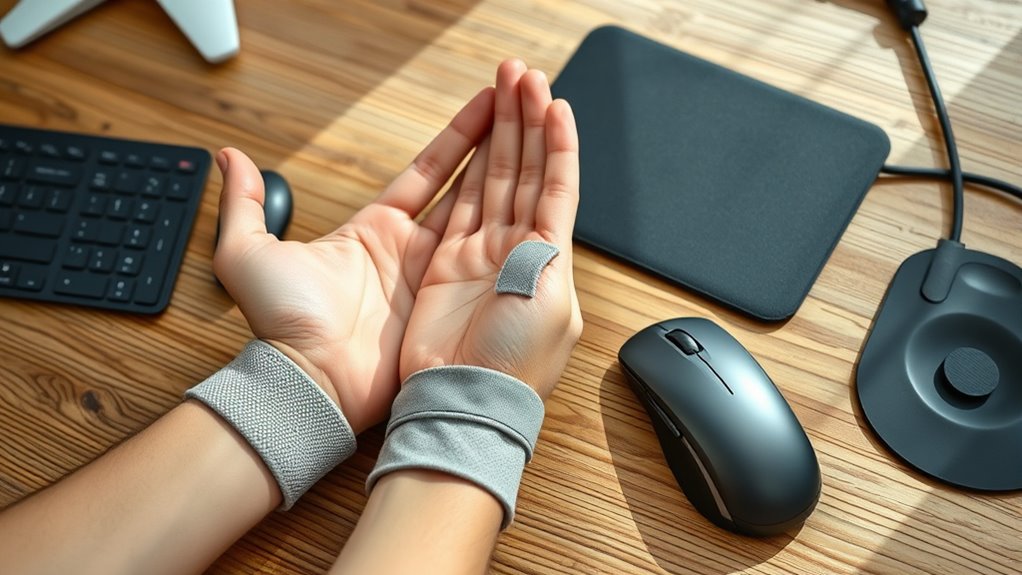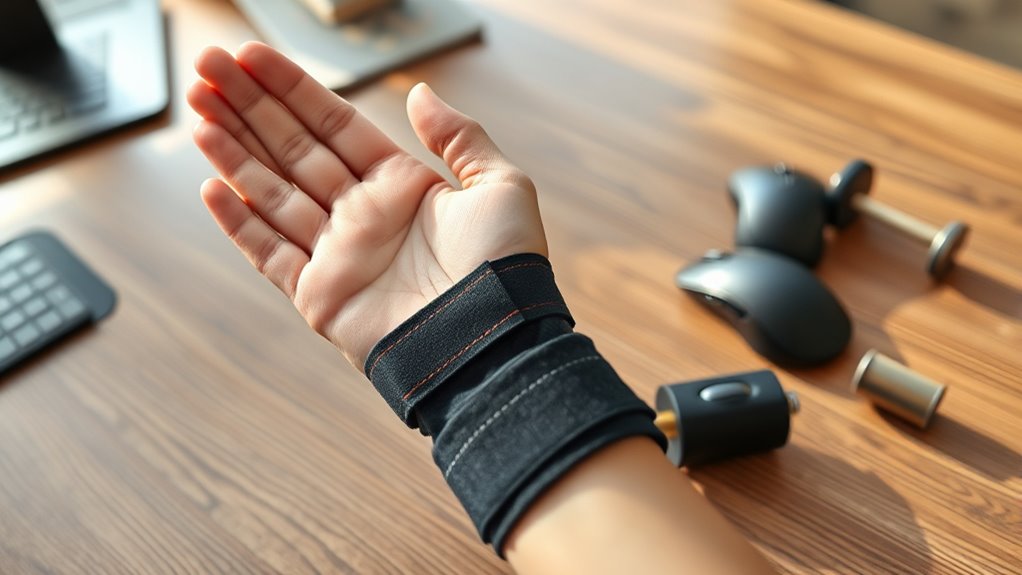To combat wrist pain, focus on ergonomic gear like supportive keyboards and wrist braces that keep your wrists in neutral positions. Incorporate gentle exercises such as wrist circles, flexion, and strengthening with resistance bands to boost flexibility and support. Taking regular breaks, maintaining good posture, and using braces during activity can prevent strain and aid recovery. Keep these strategies in mind—they can make a real difference, and you’ll discover more effective tips as you continue.
Key Takeaways
- Use ergonomic keyboards and workstation setups to promote natural wrist alignment and reduce strain.
- Wear properly fitted wrist braces during activities to stabilize and support the wrist.
- Perform gentle stretching and strengthening exercises like wrist circles and grip squeezes regularly.
- Take frequent breaks and maintain proper posture to prevent stiffness and reduce cumulative stress.
- Combining ergonomic gear, targeted exercises, and good habits helps decrease pain and prevent long-term injury.

Wrist pain can substantially impact your daily activities, but incorporating targeted exercises and using the right gear can help alleviate discomfort and promote healing. One of the most effective ways to reduce strain is to evaluate your workspace setup. If you spend hours typing, switching to ergonomic keyboards can make a notable difference. These keyboards are designed to promote a more natural wrist position, reducing the tendency to bend or twist your wrists awkwardly. When you use an ergonomic keyboard, you minimize excessive pressure on your tendons and joints, helping prevent further irritation. Pairing this with proper wrist positioning while typing can keep pain at bay and support long-term health.
Using ergonomic keyboards and proper wrist positioning can significantly reduce wrist pain and prevent long-term injury.
In addition to ergonomic keyboards, wrist braces can be a valuable tool, especially during activities that tend to aggravate your pain or when you’re experiencing flare-ups. Wrist braces provide external support, limiting movement that might cause further injury. They help maintain a neutral wrist position, reducing strain during repetitive motions or prolonged periods of typing. It’s essential to choose a wrist brace that fits well—one that’s snug but not too tight—to ensure proper circulation and comfort. Wearing a wrist brace during work, sports, or even sleep can aid in stabilizing your wrist, giving inflamed tissues a chance to heal.
Beyond gear, incorporating specific exercises into your routine can strengthen your wrists and improve flexibility. Gentle stretching, such as wrist circles or flexion and extension stretches, can increase blood flow and loosen tight muscles. Strengthening exercises, like squeezing a soft rubber ball or using light resistance bands, help build the muscles surrounding your wrist, providing better support during daily activities. Remember to perform these exercises slowly and carefully, avoiding any movements that cause sharp pain. Consistency is key here; doing these exercises daily can help improve your wrist’s resilience over time.
You should also pay attention to your posture and activity habits. Keep your wrists in a neutral position whenever possible, and take regular breaks if you’re typing or performing repetitive tasks. Setting alarms or reminders to stretch and move can prevent stiffness and reduce cumulative stress. Proper ergonomics, combined with supportive gear like wrist braces, and targeted exercises, can markedly decrease your wrist pain. They work together to reduce inflammation, improve strength, and restore mobility, making daily tasks more manageable.
Frequently Asked Questions
How Long Should I Perform Wrist Exercises Daily?
You should perform wrist stretch routines daily, aiming for about 10 to 15 minutes to see benefits without overdoing it. Follow exercise frequency guidelines by spreading out your routines throughout the day, such as morning and evening sessions, to avoid strain. Consistency is key; listen to your body and avoid pain. Regular, moderate exercises help improve flexibility and reduce wrist discomfort over time.
Are There Specific Exercises for Different Types of Wrist Pain?
Imagine opening your wrist’s potential—different exercises target specific issues. For wrist flexibility, gentle stretching helps ease stiffness, while strengthening techniques build resilience against pain. If you experience tendinitis, focus on gentle range-of-motion exercises; for sprains, prioritize stabilization. Tailoring exercises to your pain type can transform discomfort into strength, allowing you to regain control. Remember, consistency in your routine makes all the difference in healing and preventing future issues.
Can Wrist Gear Prevent Future Injuries?
Wrist gear, like a wrist brace, can definitely help prevent future injuries. When you wear a wrist brace during activities that strain your wrists, it provides support and stability, reducing the risk of overextension or sprains. Consistent use, especially during repetitive tasks or sports, improves injury prevention. Just make certain you choose the right brace and don’t rely solely on it—combine with proper technique and strengthening exercises for best results.
When Should I See a Doctor About Wrist Pain?
You should see a doctor about wrist pain if it persists beyond a few days, worsens, or if you experience severe pain, swelling, or limited movement. Early diagnosis helps prevent chronic symptoms and further injury. Don’t overlook persistent discomfort, especially if it affects your daily activities. Seeking medical advice promptly ensures you get proper treatment and reduces the risk of long-term issues with your wrist.
Are There Any Activities to Avoid While Recovering?
Think of your wrist as a delicate garden that needs careful tending. During recovery, you should avoid activities that cause rest avoidance or strain, like heavy lifting or repetitive motions. Modifying your activities, such as using ergonomic tools, helps protect your wrist. Just like overwatering a plant harms it, overusing your wrist can delay healing. Prioritize gentle activity and listen to your body to make certain a smoother recovery.
Conclusion
So, next time your wrist screams “enough,” don’t ignore it. Try those simple exercises, embrace the gear, and pretend you’re a wrist-whisperer. After all, who needs a fancy doctor when you’ve got a desk full of stress-relief tools and a determined attitude? Keep moving, stay mindful, and maybe—just maybe—you’ll outsmart that stubborn pain. Because really, if your wrist can’t handle your daily scrolls, it’s time to give it the standing ovation it deserves—rest and reset!








